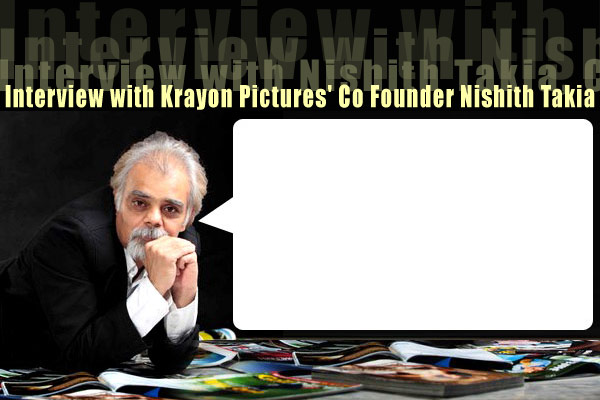
“I think its all about the belief system of the distributors and the whole value chain that is attached to an animation film.
I think if everybody believed in it as much as they should, it is definitely profitable business”
He speaks his mind and works from his heart. Krayon Pictures Co Founder Nishith Takia is an interviewer‘s delight. Speaking to AnimationXpress.com Co Founder Anand Gurnani over a coffee and sandwiches breakfast at Candies, Nish as he is more popularly known as, gave an honest feedback and perspective on how he sees the market for the Animated feature film in India and globally. ‘Delhi Safari‘ the highly awaited 3D feature film directed by Nikhil Advani, and the maiden venture of Krayon Pictures co produced by People Tree Films is nearing completion. Over the past 2 and half years, the team at Krayon has lovingly laboured and created this feature and the producer is all praise for his team… and he is equally bullish about the future of his film, his studio and about Indian animation!
Excerpts…
When you started with Krayon Pictures did you directly start with a feature film?
Yes we did. I had been planning to get into the entertainment business for a long time. For two and half years, I met different people in the industry trying to understand the business landscape. I wanted to do something where I could add value to the whole process and to the business. It looked like digital entertainment is a space in India which didn‘t have a dominant player as such and it seemed this was the space we could add value to.
I had been talking to Nikhil Advani about this since the time he was shooting Salaam E Ishq and was always nudging to do something together. He was very excited and kind enough to work with me. We bounced off some ideas and zeroed in on Delhi Safari which was earlier called Aab Delhi Door Nahi. While he was working on the story, I was working on starting the company. I didn‘t have a business card or even the name of the company when I was discussing this with Nikhil.
God has been kind and Nikhil was generous to believe in something that I wanted to do. Coincidentally I met a very old friend, Kishor Patil, who is now my co-founder and partner in our business. That‘s how we started with a small team of seven to eight people in April 2007. The script was still undergoing changes but by and large the whole idea, plot points and the rough basic draft of the film was ready. Nikhil continuously worked with writers on refining the story and the screenplay. He has taken a lot of effort in taking the script to where it is today. I think the script has turned out very well; it has all the necessary ingredients of a typical Bollywood entertainer. Animation is primarily made for the children mostly accompanied by their parents. So you have to have something in the film that should appeal to parents as well. Nikhil has taken that consideration very strongly in the film. I really feel and believe that the grown ups are also going to enjoy the film.
Is Nikhil Advani co-producing this film with you?
Yes his company People Tree is our partner. It‘s a People tree and Krayon Pictures co-production.
So it is positioned for children.
Most of the animation films around the world are targeted at children except for films like Waltz with Bashir.
Tell us about Krayon Pictures and how it was established.
I think we consciously took a decision of starting a company with an IP model, when most of the prominent players were into outsourcing. We chose to go the other way. Also when we started out, the entertainment industry worldwide was in a different place, the recession had not yet hit the industry. There were lots of animation films getting made. Hanuman had done really well. We thought it would be good to do this as we would build a property, an IP which will add value to the company and also to attract good talent. It would be very difficult to attract good artists to come to our studio and do the same outsourcing projects that they were so comfortably doing with their existing jobs. And most of the people who were working with us were with big studios from across the world and were doing a good job wherever they were. We had to build a compelling reason for them to shift and come and join us. I think the creative challenge or the creative greed if I may say, with all these artists, prompted them to shift from their comfortable jobs to a new model and an unknown company run by unknown people in the industry.
The need to create your own characters, your own backgrounds, work with the director right from the time the script is being written, I think that was the passion that drove some of the key people in our organization. Today we have a team of 150 odd people. Looking back I think that was a good decision, though I hope the markets were better.
 “The only thing we are doing since we started the company is making this film; and we have stayed focused on the film. ”
“The only thing we are doing since we started the company is making this film; and we have stayed focused on the film. ”
We have seen companies that scale up when there are projects and downsize when there are fewer projects. Companies are focused as far as projects are concerned. So is this the model Krayon will follow, or will it continue to be a 150 member studio?
We will continue to be that, we haven‘t really scaled down in spite of recession or anything. The only thing we are doing since we started the company is making this film; and we have stayed focused on the film. I think it needs that kind of investment; otherwise you can‘t build a company. The good thing is that all the people working with us have the same or increased passion for the film even after 2.5 years. The script has the elements which has fueled the fire in the people working with us to keep the enthusiasm for such a long time. The morale is still very high; the passion is probably even more. We really have a great self motivated team. So we are really fortunate and blessed.
Last year three animation films released and none of them did well. So what kind of recourse measures have you taken or have you stuck to your original plans.
We have kept with the original plan, we wish the market was better; it would have been easier on everybody. We would have been in a much more comfortable situation as far as the sales are considered. I know lot of movies have done badly including the much awaited Roadside Romeo.
Most of the people have taken a step back when it comes to buying animation films. But if you look at live action films, how many films have done well and how many have not, and the numbers are really glaring. But people are still making movies and people are still buying movies. You see Ice Age 3; it has done phenomenally good business. They must have released 10% prints in comparison to a Shahrukh Khan or Akhsay Kumar movie and has done very well with much less P&A spend. You see the advertising; P&A spend for a typical Bollywood film and compare the same to an animation film. I think its all about the belief system of the distributors and the whole value chain that is attached to an animation film. I think if everybody believed in it as much as they should, it is definitely profitable business.
I think two or three films not doing well don‘t say anything, you see Finding Nemo it did a theatrical business of USD 870 million worldwide. Tell me which Bollywood film has done that kind of business, so there is a market. In case of animation films, if the story is well told, it has a bigger audience as you don‘t need a face to sell it. A lion looks the same all over the world. He doesn‘t look black in Africa or chinky in China. So you can create universal characters that appeal to every part of the world. So it is a great story telling platform if people believe in it.
The films that do USD 500-800 million abroad are made at a cost of USD 100 million plus. In india we are making animation movies which cost probably 5% or 6% of that cost so I think if we work hard we have a much bigger chance to make money on an animation film. I still think we are very hopeful as a company and I really believe that it will change and a good story or a good film always works whether it is a live action film or an animation film. A good story will always make money at the end of the day. So I think, if we don‘t believe in our product how am I going to make anyone else believe in what we do? You have to believe and I think Nikhil and our team are making a brilliant product. It is a film everybody is going to enjoy watching.
“We couldn‘t have made this film in any other way other than animation. It‘s a compelling animation story”
Could you tell us more about the film?
The film is basically about these animals living in the Borivili National Park and it was interesting when we did research and found out that it is the largest forest land in any city in the world. There is this construction company that wants to set up homes for all of us, for people like you and me but what is happening is you are making animals homeless because you need a home and the whole idea is that. Animals are thinking just because we don‘t vote doesn‘t mean we don‘t have a right to a home. So they embark on a journey to talk to the government, the ministers to ask that where do they go? Why are humans taking away their homes? And it‘s the truth. We can notice this all over the world. If animals don‘t have a home, one day we won‘t have any planet to live on. We must learn to co-exist and let them live as much as we want to live. This is the basic message that the animals want to take to the government and the ministry saying that “do something for us”. The whole film is about their journey from Borivili national park to the parliament in Delhi. We couldn‘t have made this film in any other way other than animation. It‘s a compelling animation story. I could have never replaced the animals with human beings and made it. Also it has a global issue as there is deforestation happening all around the world.
So it has got a universal theme to it.
Yes absolutely and every where in every forest and in every part of the world. We have a very global story, but told in an Indian way. The characters in the movie travel through Gujarat on the way and meet Flamingos who play garba, which is a folk dance of Gujarat. Somewhere we are trying to show some snippets of our country, through a story which is very global. It is a very smart story and we wanted to give it a local theme because this is what we know, this is what we understand. We believe the film is going to appeal to everybody in the world. We also have Shankar Ehsan Loy lending great music and lovely songs to the film.
When it comes to the Indian distributors do you think that the reason some of them shy away from animation films is because they don‘t have international arms when animation essentially has a global audience appeal?
I really don‘t know, I think they have shied away like you rightly mentioned because a couple of films released last year didn‘t do good business. I think they are releasing live action films all around the world. They obviously have the network and the business connects. They have the relationships with the exhibitors globally to release a Shahrukh film or an Akshay film so why can‘t they release the animation films in the same theaters in the same territories. I think it‘s a whole question of their belief system and they are looking at the history and what has happened in the past and extrapolating that into the future. But I don‘t think that it is a very smart thing to do. And I am sure that if one movie does well, they will shift their attention to animation films. There are some really nice animation movies being made in the country right now as we are talking and I think India has phenomenal talent. This talent needs to be fed by a belief system that is necessary to fuel this business.
Coming to talking about yourself, your journey, your career and your previous roles and how you apply your previous experiences and learning in today‘s role?
I am basically a software engineer. Having done my masters in Computer Science from the University of Maryland, I have been in the IT business most of my life. I was also an editor with the Express Computers. I had nothing to do with cinema except that I love watching movies. Being close to some of the people in the entertainment industry they have helped fuel my passion into a profession. I love films and I never dreamt that I would be in the entertainment industry 5 years ago. I was a very happy IT guy, I love IT.
 So you were a happy IT person who loved films and suddenly you got into this profession, so you are a film person who loves IT now.
So you were a happy IT person who loved films and suddenly you got into this profession, so you are a film person who loves IT now.
Probably, I love IT and I think it is always going to be on the top of my list.
Does that reflect in your studio, your passion for IT?
This business in basically IT with creativity. IT and art is what animation is all about. I don‘t know how much I am fueling the IT drive in my company because it is a very very different kind of IT than what I did. I was into commercial application, working on mainframes and working on the web space. It was nothing to do with art or MAYA or all of that software. I wouldn‘t say that my IT knowledge or skills are being applied in my studio. I am probably the person who is more connected with the entertainment space, typically Bollywood. I am the interface to the company and the story telling part of the industry. In IT terms, I am the middleware for my company.
 You have also been talking about a lot of industry focused ideas that you have. Could you share some of that with us as a communication to our fellow industry members?
You have also been talking about a lot of industry focused ideas that you have. Could you share some of that with us as a communication to our fellow industry members?
I have been speaking to a couple of people. There was a Canadian delegation here recently and I was talking to them and I also spoke to the UK film commission here and I think that India can really play a significant role in the global animation business. Typically if you make an animation film in the western English speaking world whether it‘s Canada or the US or even UK for that matter, you cannot make a globally acceptable animation film for less than USD 30 to 40 million. Some of today‘s animation films are made for over 100 million dollars and I am sure 30 to 40 percent of the budget goes into the animation of the film. I think with the Indian skills and the Indian creativity you can make that film at a fraction of that cost. I think there are certain things that we do well and there are certain things that they do very well simply because they are way ahead of us. They know pre-production very well and the most important thing that they have is the distribution which is the last mile of every business hence the most critical mile of the business.
Instead of them looking at us just as cheap labor to feed their pipeline, they should collaborate with us for making movies together. The business model could be part payment and part profits or IP or both. India would scale to a different level and in turn the studios and the partners in the west would benefit as well. India already has the capability as they trust us to do the animation. If they just trusted us to do just a little more than that and partnered with us and worked together in making films it would benefit the whole value chain. I really feel Canada is one of the most important countries for India right now. Canada has great pre production capabilities and proximity to the holy grail of the cinema market, US. This triangular relationship can see much more happening.
Look at the IT industry, it‘s the same story. When I started my IT business, we used to send people all over the world to work on man material basis. Slowly trust increased and today IT companies in India are buying companies all over the world and they play a key role in the business models of the corporate world. The graph for the entertainment space and especially the animation space would be much shorter. The world only needs to risk trusting us. I think all of us need to talk to whoever we are working with in the world and sit and drive this proposition really hard. And maybe somewhere, the burden is on us. They are fine with the way they are working. We have to go out there and make them believe in our capabilities. I think somebody will listen or believe and that would just translate to bringing our animation industry to the next level.
Any additional comments that you would like to share?
I think India has a great future in this space. It‘s only a matter of time. Recession is going to filter out the serious players from ‘the me toos‘. Passion and inner drive will ideally drive this business. I am very optimistic and I always am. I believe that we will get there, sooner than what a lot of people believe. When I say us I mean India and not just Krayon.
 “It‘s only a matter of time. Recession is going to filter out the serious players from ‘the me toos‘.”
“It‘s only a matter of time. Recession is going to filter out the serious players from ‘the me toos‘.”
